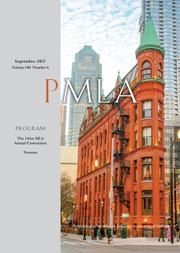No CrossRef data available.
Article contents
Resonant Texts in Noisy Spaces: Approaching the “Publics” of the Public Humanities
Published online by Cambridge University Press: 15 April 2025
Abstract
An abstract is not available for this content so a preview has been provided. Please use the Get access link above for information on how to access this content.
Information
- Type
- Theories and Methodologies
- Information
- Copyright
- Copyright © 2025 The Author(s). Published by Cambridge University Press on behalf of Modern Language Association of America
References
Works Cited
Baldwin, James. “Stranger in the Village.” Notes of a Native Son, Beacon Press, 2012, pp. 163–79.Google Scholar
Brennan, Sheila A. “Public, First.” Debates in the Digital Humanities 2016, edited by Gold, Matthew K. and Klein, Lauren F., U of Minnesota P, 2016, dhdebates.gc.cuny.edu/read/untitled/section/11b9805a-a8e0-42e3-9a1c-fad46e4b78e5.Google Scholar
Butler, Judith. “The Public Futures of the Humanities.” Dædalus, vol. 151, no. 3, summer 2022, pp. 40–53.Google Scholar
Coggeshall, Elizabeth. “Dante Today: Tracking the Global Resonance of the Commedia.” Dante beyond Borders: Contexts and Reception, edited by Havely, Nick and Katz, Jonathan, Legenda, 2021, pp. 324–37.Google Scholar
Coggeshall, Elizabeth. “Discussing the Divine Comedy with Dante: On Crowdsourcing and Transcultural Resonance.” Bibliotheca Dantesca, vol. 5, 2022, pp. 253–72, repository.upenn.edu/entities/publication/8c51d223-120b-44c2-96a8-193d5ddb7a48.Google Scholar
Damrosch, David. “World Literature in a Postcanonical, Hypercanonical Age.” Comparative Literature in an Age of Globalization, edited by Saussy, Haun, Johns Hopkins UP, 2006, pp. 43–53.Google Scholar
Dimock, Wai Chee. “A Theory of Resonance.” PMLA, vol. 112, no. 5, Oct. 1997, pp. 1060–71.Google Scholar
Dow, Gillian, and Hanson, Clare, editors. Uses of Austen: Jane's Afterlives. Palgrave Macmillan, 2017.Google Scholar
Fazel, Valerie M., and Geddes, Louise, editors. The Shakespeare User: Critical and Creative Appropriations in a Networked Culture. Palgrave Macmillan, 2017.Google Scholar
Fisher, Daniel. “A Typology of the Publicly Engaged Humanities.” Humanities for All, humanitiesforall.org/essays/five-types-of-publicly-engaged-humanities-work-in-u-s-higher-education. Accessed 22 Dec. 2024.Google Scholar
Francis. “Apostolic Letter ‘Candor Lucis Aeternae’ of the Holy Father Francis, on the Seventh Centenary of the Death of Dante Alighieri.” The Holy See, 25 Mar. 2021, www.vatican.va/content/francesco/en/apost_letters/documents/papa-francesco-lettera-ap_20210325_centenario-dante.html.Google Scholar
Harrison, Robert Pogue. “Dante: The Most Vivid Version.” New York Review of Books, 24 Oct. 2013, www.nybooks.com/articles/2013/10/24/dante-most-vivid-version/.Google Scholar
Jenkins, Henry. Convergence Culture: Where Old and New Media Collide. New York UP, 2006.Google Scholar
Jenkins, Henry. Fans, Bloggers, and Gamers: Exploring Participatory Culture. New York UP, 2006.Google Scholar
Jenkins, Henry, et al. Spreadable Media: Creating Value and Meaning in a Networked Culture. New York UP, 2013.Google Scholar
Looney, Dennis, et al. “Italian Enrollments: Trends and Concerns.” Italica, vol. 98, no. 2, summer 2021, pp. 428–41.CrossRefGoogle Scholar
Looser, Devoney. “The Hows and Whys of Public Humanities.” Profession, spring 2019, profession.mla.org/the-hows-and-whys-of-public-humanities/.Google Scholar
Meringolo, Denise D., et al. “Creating Knowledge with the Public: Disrupting the Expert/Audience Hierarchy.” Dædalus, vol. 151, no. 3, summer 2022, pp. 94–107.Google Scholar
MLA Ad Hoc Committee on Valuing the Public Humanities. Guidelines for Evaluating Publicly Engaged Scholarship in Language and Literature Programs. Modern Language Association of America, Aug. 2022, www.mla.org/Guidelines-Public-Humanities. PDF file.Google Scholar
Russell, Adrienne, et al. “Culture: Media Convergence and Networked Participation.” Varnelis, pp. 43–76.Google Scholar
Salvia, Lorenzo. “Sangiuliano: ‘Dante fu il fondatore del pensiero di destra in Italia.’ Proteste dalle opposizioni.” Corriere della sera, 14 Jan. 2023, www.corriere.it/politica/23_gennaio_14/sangiuliano-dante-fu-fondatore-pensiero-destra-italia-4c62f63e-9425-11ed-86e1-e1e0fbfb2935.shtml.Google Scholar
Smulyan, Susan. “Why Public Humanities?” Dædalus, vol. 151, no. 3, summer 2022, pp. 124–37.Google Scholar
Steinberg, Justin. “Four Ways to Ruin Dante—and One to Save Him.” Public Books, 16 June 2021, www.publicbooks.org/four-ways-to-ruin-dante-and-one-to-save-him/.Google Scholar
Terras, Melissa. “Crowdsourcing in the Digital Humanities.” A New Companion to the Digital Humanities, edited by Schreibman, Susan et al., Wiley and Sons, 2016, pp. 420–38.Google Scholar
Warner, Michael. “Publics and Counterpublics.” Public Culture, vol. 14, no. 1, winter 2002, pp. 49–90.CrossRefGoogle Scholar
West, Cornel, panelist. “African American Interpretations of Dante's Divine Comedy.” 4 Oct. 2020. Kaltura, cdnapisec.kaltura.com/index.php/extwidget/preview/partner_id/2366381/uiconf_id/42684261/entry_id/1_op4pdmee/embed/dynamic. Accessed 22 Dec. 2024.Google Scholar

